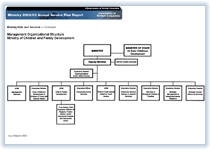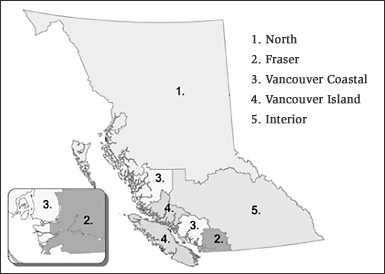 |
|
Ministry Role and ServicesMinistry Vision, Mission and ValuesThe principles contained within the ministry's vision, mission and values guide all ministry service delivery, to ensure high-quality services that promote and advance the functioning and well being of vulnerable children, adults with developmental disabilities and families. VisionThe Ministry of Children and Family Development envisions a province of healthy children and responsible families living in safe, caring and inclusive communities. MissionOur mission is to promote and develop the capacity of families and communities to:
ValuesThe following principles guide the ministry in its work:
Role and MandateThe ministry's role and mandate is to:
LegislationThrough legislation, MCFD is responsible for the child welfare system and permanency planning (adoption) for children in continuing care. In 2002/03, MCFD administered the Adoption Act; Correction Act (sections pertaining to youth justice services only); Child, Family and Community Service Act; Community Services Interim Authorities Act; Human and Social Services Delivery Improvement Act (Part 3); Human Resource Facility Act; Secure Care Act (not proclaimed); and the Social Workers Act. The following legislation also guided delivery of MCFD services in 2002/03: BC Benefits (Child Care Subsidy) Act; Community Care Facility Act; Family Relations Act; Mental Health Act; Youth Criminal Justice Act (Canada), and Young Offenders (British Columbia) Act.
Update on New Era Commitments
Ministry Operating ContextDemographic and social trends, the condition of the provincial economy, as well as internal challenges and opportunities, greatly influence the demand and provision of ministry programs and services. Budget targets and refocusing to evidence-based services Between 2002/03 and 2005/06, the ministry's budget will decline by 19 per cent, or $305 million. The ministry must meet its legislated budget targets while preserving services to vulnerable children and youth, adults with developmental disabilities and their families with greatest need. Finding efficiencies through realigning and reducing headquarters administration, refocusing contracts to evidence-based services, using family care over costly residential care where possible, and introducing individualized funding were some key ways planned to meet targets. The ministry also continued refocusing contracts to ensure they represented services that are evidence-based and produce measurable results, to help ensure that future services are available for the most vulnerable clients and their families. The shift will help meet budget targets, improve services and ensure the enhanced health and well-being of clients and their families. In 2002/03, the ministry had about 14,750 contracts for family care services, a reduction of approximately 250 from 2001/02. Families coping with various challenges In B.C., there are over 900,000 children and youth. The percentage of children in the care of the ministry, who came from families receiving income assistance, was about 65 per cent over the past decade. While about 14 per cent of all families with children at home are headed by single parents, approximately 60 per cent of children in care come from lone-parent families. The 2001 Census showed that nearly 20 per cent of B.C.'s children live below the Low Income Cut Off (LICO). Reducing the need to take children into care After years of growth in the number of children in the care of the ministry, the total number of children in care declined in 2002/03, following a trend begun since June 2001. From 1996/97 to 2001/02, the rate of children in care increased by approximately one-third, although the growth started in early 1994. In March 2002/03, it decreased to about 10.4 per 1,000, down from 10.7 per 1,000 at the start of the fiscal. Factors contributing towards a decline included legislated changes for more options than removal, emphasis on adoption for children in permanent care and greater use of family development tools to keep families safely together. However, the Aboriginal population of children in care did not notably change in 2002/03 and continued to represent about 45 per cent of all children in care at the end of March, 2003. This significantly contributed to the child in care rate stabilizing in the last four months of the fiscal and not declining to the degree the ministry had hoped and planned for. The ministry anticipates that the five Aboriginal child and family development authorities, anticipated for 2005/06, will enable more Aboriginal children and communities to be served within their own cultures, for better outcomes. Other means for better outcomes for Aboriginal children and families include more Aboriginal foster homes and Aboriginal caregivers, new or expanded delegation agreements, and more university spaces for Aboriginal social workers. Also, for 2003/04, the ministry will implement new projects with Aboriginal communities, to reconnect more Aboriginal children in care with their families and communities. Attaining better outcomes for children in continuing care Children in continuing care may significantly benefit from a plan to build on strengths and address issues. The ministry is furthering strategies to improve outcomes for these children, such as front-line use of a B.C. version of the Looking After Children (LAC) program. In 2002/03, over 150 workers completed LAC training, which assesses a child's situation, to help address difficulties, promote strengths, and plan for more positive outcomes for the child. Preventing and stopping abuse and neglect of children The 24/7 After Hours and Help Line for Children (toll free in B.C., 310-1234), received nearly 22,000 calls in 2002/03 that were related to a variety of child welfare issues such as suspected abuse or neglect. This was a slight decrease over 2001/02, with about 24,000 Help Line calls concerning those kinds of issues. Increasing adoptions for children in permanent care Adoption continued to be a regional priority to provide children in permanent care stability as well as contain in-care costs. Adoptions increased to 328 in 2002/03 compared to 243 in 2001/02 and only 163 in 2000/01, assisted by awareness campaigns, increased permanency planning, new staff training, regional recruitment positions, and contracts with licensed adoption agencies for homestudies. Community-based partnerships further helped promote adoption. Planning for more children and youth to receive mental health services Ministry records showed no significant change in staff-provided mental health service delivery to children and youth with mental disorders between 2001/02 and 2002/03, with about 10,400 clients served by staff each fiscal. Contracted service providers, accounting for half that program's budget, served thousands more. In 2002/03, improvements in data management led to an adjustment in statistics that, while lower than previously reported, was not indicative of any service reduction. In B.C., over 140,000 children and youth are estimated to have mental disorders that impair functioning. In 2002/03, government approved the ministry's Child and Youth Mental Health Plan, to improve and enhance these services across the province in the coming years. Managing youth justice Youth custody counts continued to decline in 2002/03, reflecting a national trend and reaching its lowest point in 18 years. In 2001/02, an average of 257 youth were in custody in a given period and about 2,670 were on probation. In 2002/03, about 219 youth were in custody and just over 2,450 were on probation. B.C. continued to provide nationally-recognized community-based custody alternatives, restorative justice, intensive support and supervision, which can contribute to productive outcomes for youth in the justice system. Managing increasing demand for services to adults with developmental disabilities and their families Improvements in medical technology have enabled persons with developmental disabilities to live longer, adding pressure to the lifelong services that the ministry provides these clients. Also, as aged parents are less able to care for their adult children, and as special needs children mature, caseloads may increase. The overall number of adults accessing community living services increased slightly in March 2003 to nearly 8,950 compared to March 2002 with over 8,650 clients. Between 1996/97 and January 2003, this client group grew by about 23 per cent; if that trend continues, caseloads will grow. To manage demand and budgets, the ministry and interim community living authority planned for more options around family care and direct funding, over costly residential resources, where possible. Ensuring services for those children and youth with special needs with the greatest needs The ministry provided services to about 16,000 children with special needs and their families in both 2001/02 and 2002/03. Services ranged from infant development, autism spectrum disorder (ASD) interventions, respite, child and youth care workers, to supported child care, school-aged therapy, nursing support, respite and at home assistance. In 2002/03, the number of children under age six with ASD and their families accessing autism supports increased by several hundred, due to the introduction of interim early intensive intervention programs. Plans were also announced for direct funding for eligible school-aged children and youth with ASD. Managing service transitions to community-based governance In the ministry's transition of services to community-based governance, work continued to ensure service continuity and quality and a risk management approach, to ensure mitigation of controllable risks in transition. The ministry began establishing an accountability framework with its foundations in accreditation, an outcomes approach for child and family development services, performance agreements, and readiness criteria for authorities to meet prior to assuming service delivery. The legislation that enabled establishment of the interim authority focused on a turnkey operation as part of an overall risk management strategy. Strategic ShiftsAs part of a response to the results of the Core Services Review in 2001/02, the ministry developed six strategic shifts as a guiding philosophy for service delivery and foundational context for the transition to community-based governance. The shifts are to:
Ministry StructureEach year, the Ministry of Children and Family Development's programs serve thousands of the province's most vulnerable children, youth, adults with developmental disabilities, and families with a broad variety of supports aimed at enhancing their health, safety, well-being and overall functioning. Services are provided directly by professional staff located throughout the ministry's five regions province-wide, and through contracted service providers, and emphasize strategic investments in evidence-based supports. Key areas of ministry services include:
Key priorities in 2002/03 involved activities to devolve most ministry services to 10 regional authorities, one provincial authority and planning for a potential common services entity. Five interim chief executive officers were appointed to lead regional transition activities. The new community-based service delivery structure flowed from the results of the Core Services Review, and recommendations of four provincial steering committees. Extensive input was also obtained through consultations with clients, stakeholders, staff, contracted service providers and others. It is the ministry's primary plan to ensure all services and activities meet government's broad goal of ensuring a supportive social infrastructure by providing better services for vulnerable children, families, adults with developmental disabilities, and Aboriginal communities. HeadquartersIn 2002/03, plans continued for the streamlining of headquarters. Led by the Deputy Minister, headquarters provides central support for ministry operations and will support permanent regional and provincial authorities when established. The functions of headquarters include leadership by establishing provincial legislation policies and standards; performance management of service delivery including establishment of outcome-based objectives and evaluation criteria; audits, policies and outcomes; advice and support; monitoring for quality assurance and administrative fairness; determining best practices; and maintaining strategic partnerships. Management Organizational Structure
Ministry Organization StructureRegionsServices are delivered through five regions by staff and contracted service providers. Each region is led by an interim chief executive officer. The five regions are the Fraser, Interior, North, Vancouver Coastal and Vancouver Island. Most community-based services will be transferred to the permanent provincial and regional authorities. The regions' major functions include ensuring seamless service transitions to permanent authorities; managing staff or contractor-provided service delivery; conducting regional needs assessments, conducting regional planning, evaluation and reporting; and allocating and managing funding. The regions also ensure public accountability through front-line complaint processes; equitable services for a diverse population; collaborative stakeholder and community relationships; and by establishing mandatory advisory committees with families, youth and adults with developmental disabilities. Ministry services are delivered province-wide throughout the five regions shown below. Ministry of Children and Family Development Regions
Core Business AreasFive core business areas supported the ministry's goals and objectives in 2002/03 as highlighted below. Services are provided across the province, either directly by professional staff or contracted service providers. Adult Community Living ServicesExpenditures in 2002/03: $555.7 million Key Goal: To promote an environment where adults with developmental disabilities can participate in and contribute to their communities and live a full and valued life. At the end of March 2003, this area was providing residential and day program support to 8,941 adults with developmental disabilities and their families. Services promote the increased well-being and functioning of clients in communities province-wide. Residential programs, which provide places to live while promoting greater independence and care, cover a continuum up to intensive levels, depending on need. Training and support (day) programs include self-help skills, home support, supported work, and professional support services. In 2002/03, preparations were underway to introduce individualized funding for greater client options and program sustainability. An interim community living authority was established in Fall 2002, to plan for the permanent transition of community living services for adults with developmental disabilities, and for some children and youth with special needs and their families, to the permanent community living service authority anticipated for late 2003. Youth Justice, Child and Youth Mental Health, and
|
|||||||||||||||||||||||||||||||||||||||
|
||||||||||||||||||||||||||||||||||||||||





